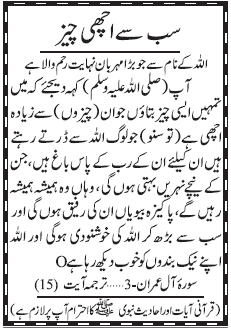Hazrat Khawaja Muhammad Chishti (ra)
Hazrat Khwaja Muhammad Chishti (r.a) was in many ways a reflection of his father and murshid. He too was a master of both shariah and tariqah, as well as a prolific author who guided many people to the path of Islam and along the suluk. Furthermore, his emphasis on ministering to the worldly needs of the poor, orphans, widows and the oppressed achieved lasting renown and engendered tremendous love and affection towards him Khwaja Muhammad Chishti(r.a) received his khilafat from his father in all the sisilahs which he transmitted, as well as from shuyukh of other orders.
He was well-known for his kindness and compassion. His khanqah was a magnet for the needy, the oppressed and the heart -weary; and he used to devote much of his time to caring for them in whatever way they required. He encouraged this among his muridin as well, and it is because of this that he was remembered with much love among the masses. Such was the beauty (jamal) of his personality, as well as the far-reaching impact of his charitable works, in fact, that he has been compared to Khwaja Nizam uddin Auliya Mehboob-e-Ilahi ( r.a)
Like his worthy father, Khwaja Muhammad (r.a) also found the time to write over forty works on various aspects of Islam. He completed his father's Tafsir Muhammadi, as well as authoring-among others-a manual describing the indicators of maarifah; Risalat al-Ilhamiyya. As mentioned previously, he compiled Majalis-e-Hasiniyya from teachings of Khwaja Hassan Muhammad (r.a)
He was a personification of zahiri (external) and batini ( internal) perfection. His life was surrounded by many miracles-although he, like his fore-bearers, took great pains to hide his spiritual state. One of the more famous of these miraculous occurrences was during a pilgrimage to the mazar of Khwaja Nasir uddin Chiragh Dehlawi (r.a). When he approached to pay his respects, onlookers were amazed to see the very grave itself opening up as if in welcome. Khwaja Muhammad entered into it, staying there for a longperiod of time engaging in contemplating and direct spiritual companionship (suhbah) with great Chishti master himself. Thereafter he emerged and the grave closed upon itself, but the crack in the casing has remained until today.
Khwaja Muhammad's (r.a) life history and works are reported to have been recorded in great detail in Misbah at Tawarikh, but this unfortunately is no longer extant. He made wisal on the 19th ( or 29th) of Rabi al Awal in 1040 AH, according to the most reliable information available. He lies buried in a shrine whose beauty , it has been said , ' reflects the beauty if his chracter,' on the banks of the river Jamman near Akbarabad. India.





 This is a free homepage created with page4. Get your own on www.page4.com
This is a free homepage created with page4. Get your own on www.page4.com